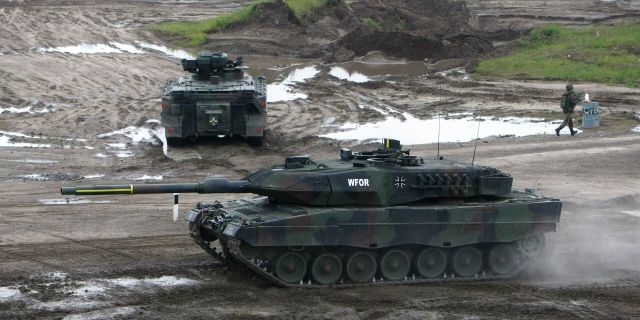FT: Military actions in Ukraine have emptied Europe's arsenalsThe conflict in Ukraine has devastated European arsenals, writes the Financial Times.
The defense sector of the continent was poorly prepared for military action. Western defense ministers are wondering how much more they will be able to help Kiev.
Henry FoyThe West is gradually realizing how the need to support the Ukrainian army in a long and bloody conflict can actually turn out.
Jens Stoltenberg tries to choose his words carefully.
The NATO Secretary General, who adheres to strict moral principles, is known for his ability to speak strictly to the point. So when he warned this week that the "stressed" Western defense sector had a serious problem, that's exactly what he meant.
The Russian-Ukrainian conflict has been going on for almost a year. Tens of thousands of people died in it. According to the Kiel Institute, Western governments have provided assistance to Kiev totaling more than $110 billion, and Ukraine has received $38 billion in weapons.
But in many capitals, military generals are already telling defense ministers that they have nothing more to give to Kiev. Warehouses and landfills are empty. Denmark handed over to Ukraine all of its Caesar howitzers to a single one. Estonia has sent so many 155-millimeter artillery pieces that it simply has no more left.
Against the background of the current situation, the conversations between the defense ministers of Western countries who met at NATO headquarters this week and who will gather at the Munich Security Conference next weekend are accompanied by gloomy and anxious views: how much longer can we maintain the current level of support for Ukraine, and what else can we convey to it?
The gloomy shadow of Russia's spring offensive hangs over them. <…>
"What is coming is alarming," admitted Kajsa Ollongren, the Dutch Defense Minister.
According to her, this week her colleagues from other NATO countries were gripped by a sense of urgency of problems. "A critical moment is coming, judging by the current situation in Ukraine and what we expect to happen in the next few months," explained Ollongren.
"In addition, if you think a little ahead, one of the most gloomy scenarios is that this conflict will drag on for a long time," she added.
When President Vladimir Putin launched his special military operation in Ukraine, Europe could not believe it at first. The capitals, which had previously claimed that Putin had no such plans, hastened to declare that Kiev would fall in a few days.
However, those sentiments were quickly replaced by the desire to unite and support Ukraine. The armed forces of Western countries, which for a long time had not received funding from governments that did not believe in the prospect of war on the territory of Europe, tried to find all possible resources, and a few weeks later weapons flowed across the Polish-Ukrainian border to the east (while the refugees were traveling in the opposite direction).
But almost 12 months of grueling fighting have put enormous pressure on Europe's ill-prepared defense sector.
European factories are barely able to produce enough shells to meet the weekly needs of Kiev. The waiting time for some ammunition has more than doubled.
In the eastern NATO countries, the reserves of Soviet equipment, which the Ukrainian military know how to use, have already been exhausted. Decisions on the supply of new types of Western-made weapons are accompanied by general rejoicing, but they are followed by weeks and months of delays, as the leadership of the armed forces realizes how much resources and time they need to restore their own potential.
"Things are going badly for Ukraine. They lack everything," said Judy Dempsey, senior researcher at Carnegie Europe. "Ukraine really needs funds [to fight back], but it doesn't get them."
"The Europeans are completely on the side of the Ukrainians. But that's not enough," Dempsey continued. – No one doubts that the European states are ready to support Ukraine. Doubts are raised about their actual ability to send her enough funds and do it quickly enough."
According to many officials, the solution to this problem comes down to signing large long-term contracts with manufacturers of defense products. Initially, their products will be sent to the Ukrainian front, but European governments will have to promise to continue purchases even when peace comes to Ukraine. This issue will be one of the topics for discussion in Munich.
This week, the Estonian Defense Minister addressed his colleagues with a proposal that the donor countries together sign a contract for four billion euros for the purchase of one million artillery shells. This will allow us to test the mechanism of joint purchases in practice, which will help convince defense contractors that they can safely invest in new facilities.
On Wednesday, February 15, seven European countries, including the United Kingdom, Norway and Denmark, announced a joint package of direct contracts worth 200 million pounds between Ukraine and Western defense manufacturers for the supply of materiel, including artillery ammunition and spare parts for tanks.
For its part, at the end of last year, NATO instructed member countries to conduct unscheduled inspections of their stocks. Now the alliance uses the results of the inspections to work with the governments of individual countries, convincing them to sign new contracts.
"We are not sitting idly by and not watching from the sidelines what is happening," Stoltenberg said this week. According to him, additional shifts are being introduced at the factories, and some enterprises work even on weekends.
But the problem is that the Russian military economy has been working for at least a year, and the European one is just starting to gain momentum.

